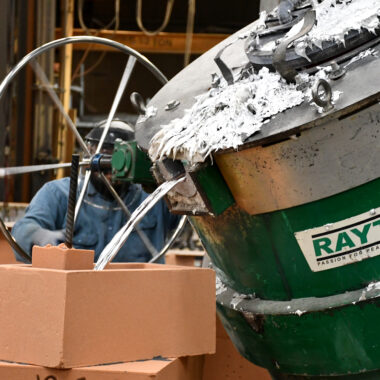Exploring the Craft: All About Aluminum Casting Techniques
Exploring the Craft: All About Aluminum Casting Techniques
Blog Article
Crafting Excellence: Exactly How to Attain High-Quality Light Weight Aluminum Castings Every Time
In the world of light weight aluminum casting, the pursuit of perfection is a constant journey that calls for a careful strategy and an eager understanding of the ins and outs entailed. Attaining consistent top quality aluminum spreadings requires an extensive grasp of the procedures, from choosing the ideal alloy to carrying out precise mold designs and diligently managing spreading specifications.
Understanding Aluminum Casting Procedures
Light weight aluminum casting processes, essential in the manufacturing industry, involve the intricate transformation of liquified light weight aluminum right into strong kinds with a series of very carefully controlled actions. Understanding these processes is paramount to achieving premium light weight aluminum castings continually - about aluminum casting. The primary methods made use of in light weight aluminum spreading are die casting, sand casting, and investment casting

Each of these processes has its advantages and is chosen based on elements like complexity, quantity, and preferred surface of the aluminum casting. about aluminum casting. Understanding the intricacies of these approaches is essential for suppliers aiming to create high-grade light weight aluminum castings consistently
Picking the Right Aluminum Alloy
Selecting the suitable aluminum alloy is a crucial decision in the manufacturing of high-quality light weight aluminum castings. When choosing a light weight aluminum alloy for spreading, it is essential to take into consideration the specific needs of the application to make sure optimum performance.
One of one of the most commonly used light weight aluminum alloys for casting is A356. This alloy offers exceptional castability, high strength, and excellent rust resistance, making it ideal for a wide variety of applications. Conversely, 6061 aluminum alloy is favored for its superior weldability and good mechanical buildings. For applications requiring high strength, 7075 light weight aluminum alloy is a popular option because of its extraordinary strength-to-weight ratio.
In enhancement to mechanical residential or commercial properties, considerations such as cost, schedule, and post-casting procedures ought to also affect the choice of the best aluminum alloy. By carefully reviewing these factors, producers can make certain the production of top quality light weight aluminum castings that satisfy the preferred requirements.
Applying Correct Mold Style
Creating an effective mold and mildew layout is important for making sure the effective manufacturing of high-grade aluminum castings. Correct mold layout plays a considerable role in achieving the wanted attributes of the end product. To execute a successful mold and mildew design, factors such as material circulation, cooling prices, and component geometry should be carefully taken into consideration.
One secret facet of mold and mildew layout is making certain proper filling and solidification of the light weight aluminum within the mold and mildew cavity. This entails designing jogger and gating systems that promote smooth steel flow and stop defects such as air entrapment or insufficient dental filling. Furthermore, incorporating cooling channels right basics into the mold and mildew layout aids control solidification rates and minimize the danger of porosity or contraction flaws.

Controlling Spreading Parameters

Making Sure Post-Casting Quality Checks
To preserve the high top quality of light weight aluminum spreadings, extensive post-casting quality checks are essential. After the casting procedure is completed, it is important to guarantee that the final products fulfill the wanted requirements and requirements.
Dimensional accuracy is one more vital element that needs to be validated throughout post-casting high quality checks. Dimensions of essential dimensions and resistances ought to be required Visit Your URL to validate that the spreadings satisfy the called for specs. Furthermore, mechanical buildings such as firmness, tensile toughness, and influence resistance might need to be reviewed via material screening to make sure that the spreadings possess the needed stamina and resilience for their intended application.
Final Thought
To conclude, achieving top notch light weight aluminum spreadings needs a detailed understanding of the spreading procedures, choosing the proper alloy, developing molds effectively, controlling spreading criteria thoroughly, and conducting post-casting top quality checks vigilantly. By adhering to these actions, manufacturers can constantly create light weight aluminum spreadings that fulfill the highest possible standards of high quality and efficiency.
Attaining regular high-grade aluminum castings demands a thorough understanding of the procedures, from picking the proper alloy to executing exact mold and mildew styles and thoroughly regulating casting criteria. The primary approaches utilized in aluminum spreading are pass away spreading, sand spreading, and investment spreading.
Financial investment spreading, also known as precision casting, involves producing wax patterns that are coated in ceramic to create mold and mildews.Choosing the appropriate light weight aluminum alloy is a critical decision in from this source the manufacturing of high-grade light weight aluminum spreadings.Ensuring specific control over spreading criteria is crucial for preserving uniformity and top quality in aluminum casting production.
Report this page